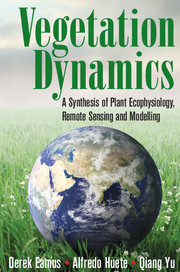Book contents
- Frontmatter
- Contents
- Preface
- Section One Plant Ecophysiology
- Section Two Remote Sensing
- Section Three Modelling
- Section Four Case Studies
- 14 Boreal Forests
- 15 Arid and Semi-Arid Grasslands
- 16 Savannas
- 17 Seasonal Behaviour of Vegetation of the Amazon Basin
- 18 Tropical Montane Cloud and Rainforests
- 19 Groundwater Dependent Ecosystems
- 20 Global-Change Drought and Forest Mortality
- Index
- References
20 - Global-Change Drought and Forest Mortality
from Section Four - Case Studies
Published online by Cambridge University Press: 05 June 2016
- Frontmatter
- Contents
- Preface
- Section One Plant Ecophysiology
- Section Two Remote Sensing
- Section Three Modelling
- Section Four Case Studies
- 14 Boreal Forests
- 15 Arid and Semi-Arid Grasslands
- 16 Savannas
- 17 Seasonal Behaviour of Vegetation of the Amazon Basin
- 18 Tropical Montane Cloud and Rainforests
- 19 Groundwater Dependent Ecosystems
- 20 Global-Change Drought and Forest Mortality
- Index
- References
Summary
Introduction
In the past century, atmospheric CO2 concentrations have increased by approximately 110 ppm. During this time, average global surface temperatures have increased by almost 1°C. Over the past fifty years, annual rainfall across large areas of all continents has substantially declined periodically, often for several-to-many years consecutively, resulting in widespread and prolonged drought conditions. While drought is a recurrent feature of global weather patterns, the areal extent, duration, and intensity, of these droughts is unprecedented. Consequently, widespread forest (and grassland) mortality is occurring in response to these droughts. The loss of such large areas of vegetation has major negative impacts on the provision of ecosystem services, landscape albedo, carbon, water and energy balances, soil erosion and biodiversity.
Field assessments of mortality have been undertaken extensively in the United States and Europe, but less extensively in Asia and Australia, where population density is often low across extensive regions and scientific staff and resources tend to be concentrated in cities. Application of remote sensing to regional-scale mortality has been undertaken in the past decade and these studies have been invaluable in quantifying the timing and extent of regional die-back and mortality. In addition, models of the mechanisms of mortality are being developed and these are briefly discussed.
Vegetation mortality (forests and grasslands in particular) have experienced climate-change induced droughts that have persisted for two to seven years across all continents over the past fifty years. The combination of reduced water supply and increased vapour pressure deficit and temperature have resulted in excessive and unrepaired embolism, fatal canopy dehydration, and fatal depletions of carbon stores. Associated decreased resistance to biotic (fungal, insect) stress can also provide the final push into widespread mortality. Remote sensing has provided indices of the climatic drivers, the aerial extent, and the timing of these events.
The three big questions addressed in this case study are: (1) where is regional-scale vegetation mortality occurring; (2) what in regional climate systems is causing mortality; and (3) what mechanisms may link climate to vegetation mortality?
Global Change-Type Droughts
Drought can be defined as a period of time when rainfall is lower than the long-term average for a given site. Droughts can persist for periods of months-to-years and to more than a decade (Table 20.1).
- Type
- Chapter
- Information
- Vegetation DynamicsA Synthesis of Plant Ecophysiology, Remote Sensing and Modelling, pp. 484 - 512Publisher: Cambridge University PressPrint publication year: 2016



